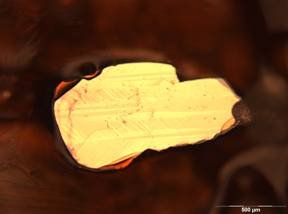Nov 27 2009
Is it possible to make even more compact digital memories for portable electronic devices and which consume even less energy? A team of CNRS and CEA researchers has recently demonstrated that it is feasible, thanks to a new class of materials known as multiferroics, which combine unusual electric and magnetic properties.
 Image of the ferroelectric domains of the multiferroic compound BiFeO3 © A. Mougin, CNRS 2009
Image of the ferroelectric domains of the multiferroic compound BiFeO3 © A. Mougin, CNRS 2009
At a microscopic scale, atoms and molecules produce electric and magnetic fields. At our own scale, in the majority of crystals, the electric and magnetic properties of the various atoms offset one another and cancel each other out. Sometimes, however, this is not the case and in certain compounds, known as ferromagnetics, magnetic properties subsist at a macroscopic scale and can therefore act as a magnet. Less commonly, an electric order can exist at the macroscopic scale; such is the case with what are known as ferroelectric compounds. Even more rarely, electric and magnetic orders exist at one and the same time, as is the case with multiferroic materials. Moreover, in these materials, the electric and magnetic orders interact. Such interaction offers the opportunity of controlling the spins (the magnetic moments) of the atoms via an electric field, thus opening whole new perspectives particularly as regards information storage.
Researchers at the Laboratoire de Physique des Solides (CNRS/Université Paris-Sud 11), the Institut Rayonnement-Matière de Saclay (CEA Iramis) and the Institut Néel (CNRS) first synthesized the multiferroic compound BiFeO3 and then demonstrated the interaction between its electric and magnetic orders. They then produced a material formed of a layer of BiFeO3 and a ferromagnetic film and showed that they were able to modify the preferential orientation of the magnetization of the ferromagnetic film by applying an electric field. These pioneering results validate the concept of storing and writing magnetic data using an electric field.
In today's hard discs, data - or bits - are written using a magnetic field that directs the magnetization, which imposes the bit value. There are two possible magnetization states and thus two possible bit values (designated 0 or 1). With a multiferroic material, each memory element could be placed in four distinct states instead of two (two electrical polarization states and two magnetization states). Magnetic memories with two states (like existing memories), but which can be modified through the application of an electric field, could also be envisaged. This possibility of writing and erasing data using an electric field constitutes a decisive advantage in mobile electronic devices (mobile phones, laptop computers, GPS, etc.) from two points of view. Firstly, the application of an electric field requires less energy than the application of a magnetic field and therefore batteries would last longer. Secondly, the electric field would be more local, which would mean more memory elements could be packed onto a given surface and thus enable component miniaturization to be pushed even further.